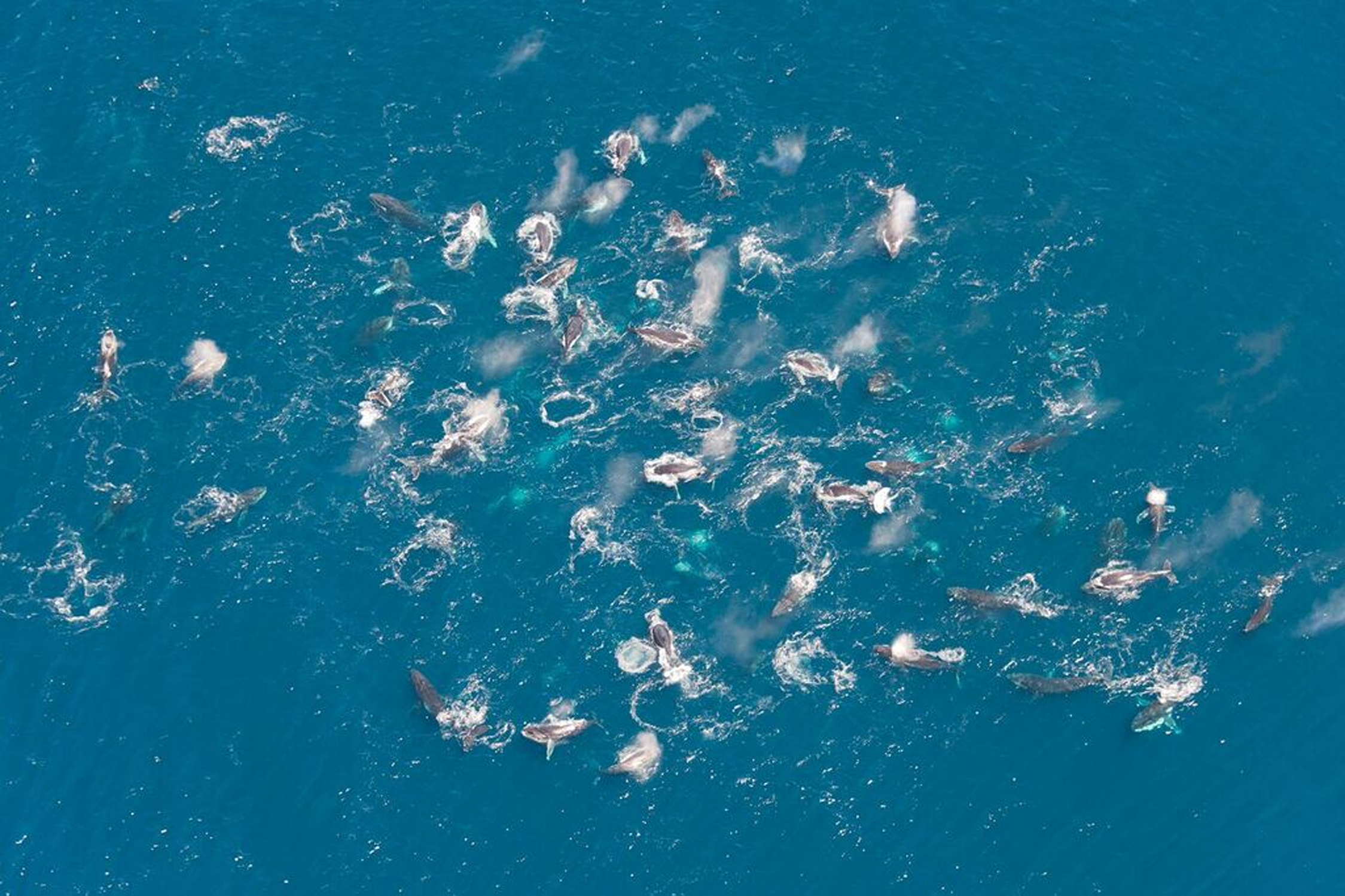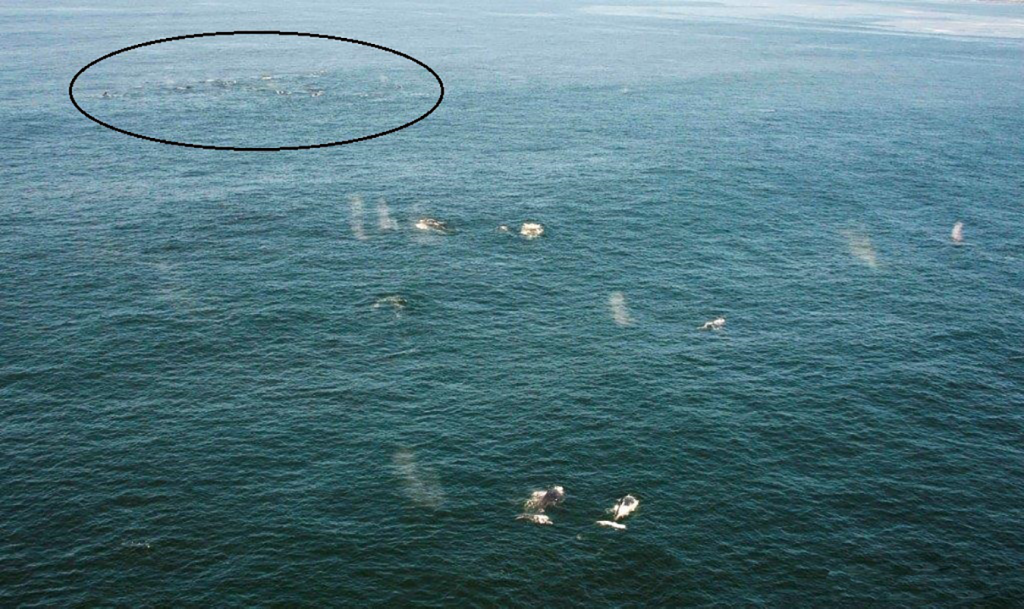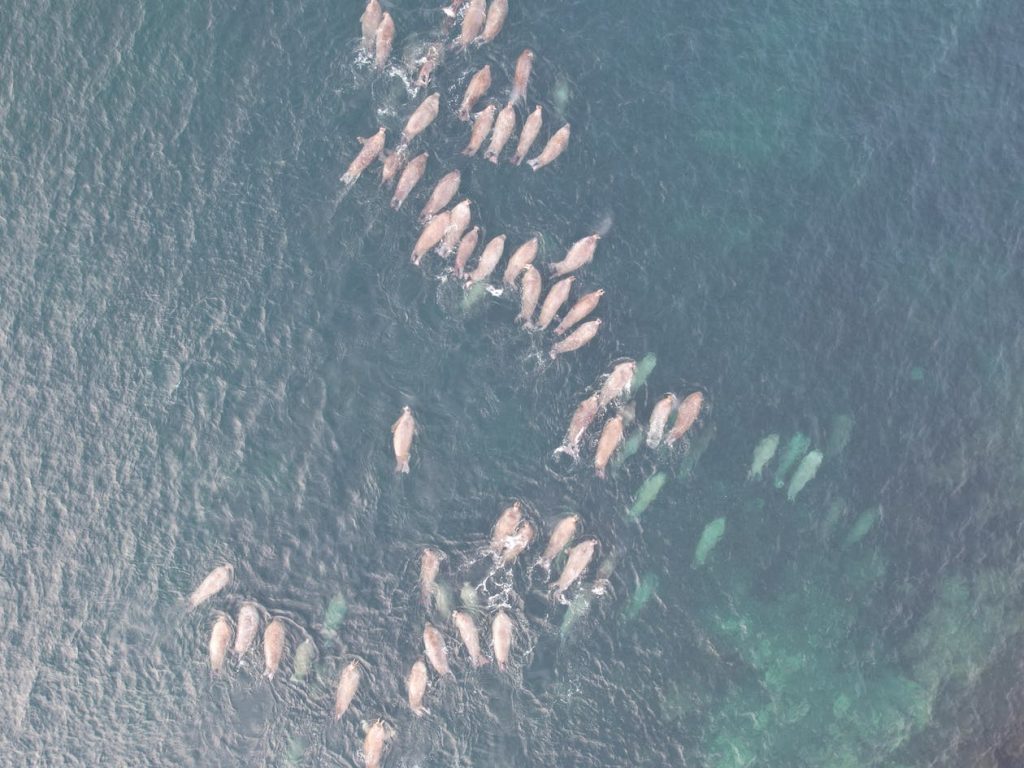Your cart is currently empty!
Humpback Whales Gathered in Groups of Up to 200, and No One Knows Why

Marine biologist Ken Findlay expected another routine research cruise off South Africa’s coast. Instead, he encountered something that defied everything scientists know about humpback whale behavior. Ahead of his vessel, the ocean surface erupted with activity. Massive dark shapes breached and dove in perfect synchrony. Spouts shot skyward in rapid succession across an area no larger than a football field.
What Findlay witnessed should have been impossible. Humpback whales are known as ocean wanderers, traveling alone or in small family pods of three to seven individuals. Yet here, packed into tight formation, were dozens upon dozens of these 30,000-kilogram giants. Something had drawn them together in numbers never before documented by science.
“I’ve never seen anything like this,” Findlay would later say, his voice carrying the weight of decades spent studying marine mammals across the Southern Hemisphere.
Between 2011 and 2015, research teams documented 22 separate incidents of these mysterious gatherings. Scientists scrambled to understand what they were witnessing. Humpback whales, it seemed, were rewriting the rules of their own existence.
Record-Breaking Gatherings Stun Scientists

Each “super-group” contained between 20 and 200 individual whales, floating so close together that researchers could barely distinguish one animal from another. Many whales positioned themselves within five body lengths of their neighbors, some separated by mere meters. Aerial observers reported scenes resembling floating cities of marine mammals, their dark backs creating intricate patterns across the ocean surface.
Research vessels equipped with echo-sounders detected the animals diving in coordinated waves, disappearing into the depths before resurfacing minutes later in slightly different configurations. Individual whales moved between groups like party guests mingling at a reception, joining and leaving clusters throughout the day.
Flight crews conducting routine surveys double-checked their equipment. Commercial fishermen radioed coastal authorities, uncertain whether what they were seeing constituted a medical emergency or a natural phenomenon. Even seasoned whale researchers found themselves struggling to count the animals, as traditional group-size estimation methods broke down when faced with aggregations of this magnitude.
Water depths where these gatherings occurred ranged from 32 to 86 meters, spanning a 200-nautical-mile stretch of coastline. No specific bathymetric features seemed to attract the whales. Instead, they appeared distributed across the southern Benguela Upwelling System, from the Columbine upwelling cell in the north to the Cape Peninsula upwelling cell in the south.
Wrong Place, Wrong Time for Whale Behavior
Location and timing made these gatherings even more puzzling. During Southern Hemisphere summer months, humpback whales should be thousands of kilometers south, gorging themselves on Antarctic krill. Instead, these animals had chosen to congregate in South African waters, far from their traditional feeding grounds.
Humpback migration follows a predictable annual cycle. Summer finds them in polar regions, where they consume massive quantities of small prey to build fat reserves for the journey ahead. As winter approaches, they travel north to tropical and subtropical waters for mating and calving. Pregnant females give birth in warm, shallow lagoons before beginning the return journey with their newborn calves.
Yet here were hundreds of whales, appearing consistently during October and November for five consecutive years, disrupting migration patterns established over millions of years of evolution. Research teams found themselves documenting behavior that challenged fundamental assumptions about humpback whale biology.
Satellite tracking data from tagged individuals revealed additional mysteries. Six of eight whales eventually migrated south toward Antarctica, but four first traveled north for 100 to 150 nautical miles before reversing course. Such detours consume precious energy reserves that should be directed toward polar feeding activities.
Feeding Frenzy in Unexpected Waters

Close observation revealed these whales weren’t simply resting or socializing. They were actively feeding, exhibiting all the classic signs of intensive foraging behavior. Researchers documented surface lunging, where whales burst through the water with mouths agape, engulfing whatever prey they encountered.
Repetitive deep diving dominated group dynamics. Animals would disappear for several minutes before resurfacing in tight formation, their synchronized movements suggesting coordinated hunting strategies. Underwater exhalations created massive bubble clouds visible from research vessels, a technique humpbacks use to confuse and concentrate prey.
Chemical signatures provided additional evidence. Whale blows carried a sharp, “fishy” odor distinct from the oily scent typically associated with humpbacks on breeding grounds. Brick-red fecal matter floating near the groups indicated recent feeding activity. Cape gannets, terns, and Cape fur seals gathered around the whale aggregations, taking advantage of disturbed prey brought to the surface.
On two occasions, fin whales joined the gatherings. Southern right whales were observed within super-groups twice, creating mixed-species feeding associations rarely documented in scientific literature. Such interspecies cooperation suggests prey concentrations significant enough to attract multiple whale species simultaneously.
Prey Mystery Deepens Investigation
Identifying what these whales were eating proved challenging. Research protocols prohibited deploying plankton nets near the tightly packed groups, as sampling equipment posed entanglement risks to diving whales. However, circumstantial evidence pointed toward specific prey species.
Mantis shrimp and small crustaceans appeared at the surface within super-groups. Echo-sounder readings detected dense acoustic targets near the seafloor, suggesting massive prey aggregations. Commercial fishing vessels operating in the same areas caught snoek fish with stomachs full of mantis shrimp, indicating abundant populations of these crustaceans.
One entangled humpback whale provided direct evidence. When researchers examined the animal’s stomach contents, they found only young adult mantis shrimp, a predominantly benthic species that occasionally swarms in pelagic waters. Such concentrated feeding on a single prey type suggested the whales had encountered exceptionally dense aggregations.
Historical records from early 20th-century whaling operations mentioned humpbacks feeding on “herrings,” mantis shrimp, and various crustaceans in the same region. Scientists began wondering whether current observations represented the return of feeding behaviors lost during the whaling era.
Population Boom Theory Gains Traction

Commercial whaling nearly drove humpback whales to extinction. By the early 20th century, populations had collapsed by more than 90 percent, with some regions reduced to only a few hundred surviving whales. Strict protection measures introduced in the 1960s and 1970s set the stage for recovery, and today global numbers are estimated at 80,000 to 100,000 whales.
Australia’s east coast humpback population has reached its healthiest levels since whaling ended in the 1960s. Similar recovery trends are occurring throughout the Southern Hemisphere, creating population densities not seen for over a century.
“Either the availability of prey has changed or the behavior of the whales has changed,” Findlay explains, acknowledging the complex relationship between population recovery and feeding strategies.
Increased whale numbers could be intensifying competition for traditional Antarctic prey resources, forcing some animals to seek alternative feeding opportunities. Young, non-breeding whales might be particularly willing to experiment with new feeding areas, as they face less pressure to follow established migration routes.
Climate and Ocean Changes Factor In
Ocean conditions off South Africa have changed substantially over recent decades. Long-term studies document shifts in neritic zooplankton communities, with smaller species now dominating areas previously ruled by larger prey. Warming waters and altered current patterns may be redistributing marine food webs in ways that benefit different whale feeding strategies.
Upwelling systems like the Benguela Current create areas of exceptional productivity, concentrating nutrients and supporting dense prey populations. Climate change could be intensifying these upwelling patterns, creating temporary feeding bonanzas that attract opportunistic predators.
Research teams noted that many whales in the super-groups appeared smaller than typical adults, estimated at 8 to 10 meters in length. Only one calf was observed across more than 30 group encounters, suggesting these gatherings primarily involved non-breeding animals with flexible migration schedules.
Ancient Behavior Returns from Shadows
Historical records hint that current super-groups might represent restored behavior patterns rather than entirely new phenomena. Whaling records from 1914 mention summer feeding by humpbacks off South Africa’s west coast, before industrial hunting eliminated most whale populations from the region.
Early 20th-century accounts describe young male humpbacks present in southern Benguela waters throughout the summer months, suggesting some animals historically suspended migration to take advantage of local feeding opportunities. Current super-groups could represent the restoration of feeding strategies lost for over a century.
As whale populations recover, they may be rediscovering productive feeding areas their ancestors used before the whaling era. Alternatively, a small number of whales might have maintained these feeding traditions throughout the population collapse, with recent observations becoming visible only as group sizes reached detectable levels.
Research Teams Race for Answers
Scientists are launching comprehensive studies to understand super-group formation and persistence. Photo-identification projects track individual whales between groups and across seasons. Satellite tags monitor movement patterns, diving behavior, and migration routes. Acoustic monitoring documents whale vocalizations and prey detection activities.
“We propose that the ‘super-group’ feeding phenomenon (as tightly spaced large groups of whales) is a relatively recent behaviour exhibited by these whales,” researchers concluded in their published study.
Future research priorities include determining the geographic origin of super-group participants, modeling the energetic advantages of suspended migration, and examining prey species identity and abundance. Teams are developing new group-size estimation methods capable of handling aggregations that exceed traditional counting techniques.
Collaboration between marine biologists, oceanographers, and fisheries scientists aims to understand ecosystem changes driving these novel behaviors. Such interdisciplinary approaches may reveal broader patterns of ocean change affecting multiple marine species.
Conservation Questions Loom Large

Super-group discoveries raise important questions about marine conservation planning. If South African waters are becoming permanent seasonal feeding grounds, existing protected area boundaries may require adjustment. Shipping routes, fishing activities, and coastal development could impact whale feeding success.
Current marine protected areas in the region were designed based on historical whale distribution patterns that may no longer reflect reality. Super-groups create opportunities for whale-watching tourism but also increase risks from vessel strikes and acoustic disturbance.
International whaling regulations assume humpbacks follow predictable migration patterns between specific breeding and feeding areas. Animals that suspend migration or establish new feeding grounds challenge existing management frameworks designed to protect traditional patterns of habitat use.
What Comes Next for Ocean Science
Humpback super-groups offer scientists unprecedented opportunities to study whale feeding behavior in accessible locations. Unlike remote Antarctic research, South African waters allow year-round observation from land-based stations and regular vessel surveys.
Such accessibility could revolutionize understanding of baleen whale social organization, communication systems, and cooperative feeding strategies. Super-groups provide natural laboratories for investigating how whales coordinate group activities and share information about prey resources.
Marine biologists recognize these observations as reminders of the vast amount that remains unknown about ocean ecosystems. Species once thought fully understood continue to reveal new behaviors as environmental conditions change and populations recover from historical exploitation.
Whether super-groups represent climate adaptation, population recovery effects, or restoration of ancient behaviors, they demonstrate the capacity of large marine mammals to surprise scientists who thought they had decoded the rules governing ocean life.
